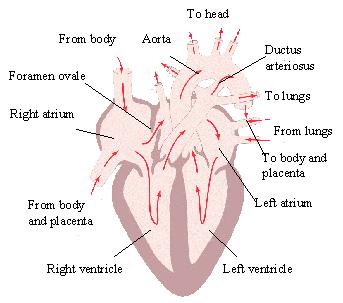Ontogeny of the vascular reactivity of the ductus arteriosus in the chicken embryo
Introduction

The fetus is a water living organism, receiving oxygen from the mother’s blood through the placenta, while the newborn infant and later adult is air breathing, using its lungs for respiration. Therefore several special structures are necessary for fetal blood flow and respiration: the placental circulation; the crossover in the heart by the foramen ovale, and the shunt between the two arterial systems by the ductus arteriosus are the most important. Following birth all these structures become non-functional, and change rapidly after birth.
The chicken embryo is an important model for studying developmental changes in vascular reactivity. It has a circulation similar to humans, and the development in the egg, makes it suitable for this type of studies. In this project I have investigated the developmental changes in the ductus arteriosus, one of the important vessels in fetal life, to several substances.
Abstract
The ductus arteriosus (DA) is a shunt vessel, connecting the main pulmonary artery with the descending aorta during fetal life. At the time of birth, the DA should close. Although numerous investigations on ontogeny of vascular reactivity in the DA of several mammalian species have been performed, several aspects remain unclear. The chicken embryo presents an interesting model for studies of development in the circulation, and the ontogeny of vascular reactivity of the pulmonary, femoral and carotid arteries have already been studied. But until now the vascular reactivity of the chicken DA has not been characterized. This study focuses on the developmental changes in contractile and relaxant responses to several vasoactive agents in chicken embryo DA by means of wire myography. The contractile agents (potassium, noradrenaline, endothelin-1 and U46619) caused increasing responses between 15 and 19 days, which not only depended on development of the contractile apparatus. Relaxing responses to sildenafil increased, while acetylcholine-induced relaxations decreased, suggesting an increase in basal production of NO and a decrease in the stimulated response. Oxygen augmented contractions induced by noradrenaline, whereas acetylcholine- and sodium nitroprusside-induced relaxations were impaired with high oxygen concentrations, and a direct response to oxygen was only observed in 21-day embryos. The remarkable development of the response to noradrenaline in the DA with incubation, while the poorly developed response in the pulmonary arteries even decreases with age, makes it tempting to suggest a special role for noradrenaline in the closure of the ductus in the chicken embryo.
Download a pdf!
I will later put my thesis here, but due to publication issues, it will come later.
Responsible for this page:
Director of undergraduate studies Biology
Last updated:
06/22/05
